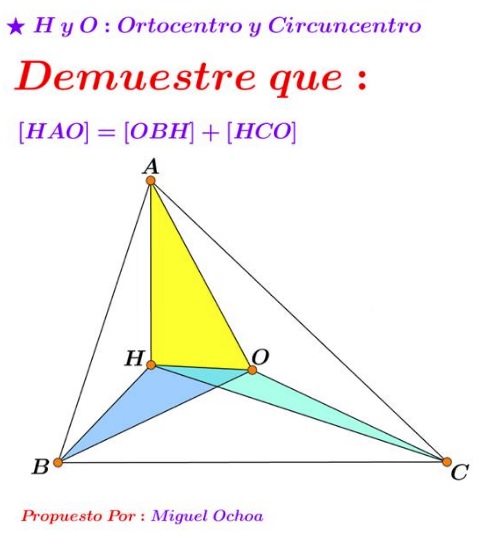Triangles on HO
Source

The problem has been shared by Miguel Ochoa Sanchez at the Peru Geometrico facebook group.
Remark and Reformulation
As stated, the problem is incorrect: It is not always true that $[\Delta AHO]=[\Delta BHO]+[\Delta CHO].\,$ The suspicion may be aroused by the lack of symmetry in the formulation: both the orthocenter $H\,$ and the circumcenter $O\,$ are symmetric functions of the vertices of $\Delta ABC.\,$ There is no reason to single out one of the vertices. The improved formulation is as follows:
Assume $[XYZ]\,$ denotes the signed area of $\Delta XYZ.\,$ Then, with $H\,$ the orthocenter and $O\,$ the circumcenter of $\Delta ABC,\,$
$[AHO]+[BHO]+[CHO]=0.$
A Better Formulation
The problem, as stated above, appears somewhat artificial. Let $h_A,\,$ $h_B,\,$ $h_C,\,$ be the altitudes of the three triangle involved to the line $HO.\,$ Since all three have the same base $(HO)\,$ the problem reduce to proving that
$h_A+h_B+h_C=0.$
(This in fact explains the idea of signed areas: depending on the position of the vertices relative to the line $HO,\,$ the altitudes may be either positive or negative.)
Remarkably, the above condition does not depend on the specific common base of the three triangles. As the line $HO\,$ is the Euler line of $\Delta ABC,\,$ it is obvious that for any two points $P,Q\,$ on the Euler line we'll have
$[APQ]+[BPQ]+[CPQ]=0.$
Thus, inclusion of $H\,$ and $O\,$ in the formulation is a red herring. But this is not the only red herring in the formulation. What makes the Euler line so special as to possess such a nice property? To make sure, the Euler line is a very special construct in every triangle, but the condition $h_A+h_B+h_C=0\,$ seems too general to be strictly and rigidly associated with the Euler line. Indeed, if we imagine unit masses placed on the vertices of the triangles, the equation $h_A+h_B+h_C=0\,$ will simply assert that the moments of the system of three masses with respect to $HO\,$ is zero, i.e., the system is in equilibrium. This observation removes the mystery in the appearance of the Euler line. The Euler line passes through $H,\,$ $O,\,$ but - in this case - more importantly - through $G,\,$ the centroid, i.e., the barycenter of the triangle. For every line though the centroid of $\Delta ABC,\,$ the required condition will hold!
Assume line $\ell\,$ passes through the centroid $G\,$ of $\Delta ABC.\,$ Let $h_A,\,$ $h_B,\,$ $h_C,\,$ denote the signed distance from the vertices $A,\,$ $B,\,$ and $C\,$ to the line $\ell.\,$ Then
$h_A+h_B+h_C=0.$
What Is Red Herring
- On the Difference of Areas
- Area of the Union of Two Squares
- Circle through the Incenter
- Circle through the Incenter And Antiparallels
- Circle through the Circumcenter
- Inequality with Logarithms
- Breaking Chocolate Bars
- Circles through the Orthocenter
- 100 Grasshoppers on a Triangular Board
- Simultaneous Diameters in Concurrent Circles
- An Inequality from the 2015 Romanian TST
- Schur's Inequality
- Further Properties of Peculiar Circles
- Inequality with Csc And Sin
- Area Inequality in Trapezoid
- Triangles on HO
- From Angle Bisector to 120 degrees Angle
- A Case of Divergence
- An Inequality for the Cevians through Spieker Point via Brocard Angle
- An Inequality In Triangle and Without
- Problem 3 from the EGMO2017
- Mickey Might Be a Red Herring in the Mickey Mouse Theorem
- A Cyclic Inequality from the 6th IMO, 1964
- Three Complex Numbers Satisfy Fermat's Identity For Prime Powers
- Probability of Random Lines Crossing
- Planting Trees in a Row
- Two Colors - Three Points
|Contact| |Front page| |Contents| |Geometry|
Copyright © 1996-2018 Alexander Bogomolny73569116
